Exploring Early Human Presence in West Central Africa’s Rainforests: Archeo-Paleontological Surveys, Taphonomy, and Insights from Living Primates in Equatorial Guinea
Abstract
1. Introduction
2. Archeo-Paleontological Aspects
2.1. Geological Context of the Archeo-Paleontological Record
- (a)
- The basins (semigrabens) with Miocene sediments generated in events of high tectonic activity and located following faults in the eastern half of the country, with an east–west orientation [16,17] (Figure 1). Unfortunately, we have found that the alteration processes of all sedimentary deposits below the vegetation cover lead to a homogenization of the materials and destruction of the stratigraphic organization. In fact, it has not been possible to clearly delimit any of the semigrabens indicated in the geological maps, and it seems extremely unlikely that a Miocene fossil record is preserved throughout Equatorial Guinea.
- (b)
- Quaternary sediments deposited in coastal, fluvial, and lacustrine environments. The characterization of this type of depositional environments has allowed for the location of sedimentary singularities which, in some cases, have allowed for the recovery of archaeological records [18]. This is the case of the fluvial and deltaic environment sites in the Río Campo area, associated with different migration phases of the Ntem River [19,20]. In turn, discoveries of paleolacustrine deposits in an ancient maar located on the west coast of Bioko Island [21,22] and intramontane basins located in the heart of the Monte Alén Nature Reserve present great future potential for paleoclimatic studies.
- (c)
- Eluvial materials resulting from the in situ decomposition of the basal rocks that give rise to alteration profiles. Many of these profiles end up forming structures grouped under the generic and not very specific term of stone lines. It is not uncommon to find more or less dispersed pieces of lithic industry in these profiles [23,24]; a phenomenon already detected by Mercader [25]. In this context, attention has been paid to the complex processes of formation of these ‘stone lines’, a phenomenon widely mentioned in the field of geology and archeology in Africa. These phenomena are in some cases associated with purely geological processes, while in some other contexts they may themselves form archeological sites that are difficult to explain taphonomically. Stone lines present different morphologies, which points to a wide variety of formative processes, among which allochthonous processes (coarse materials have undergone transport) and autochthonous processes (without transport, whose formation is in situ) can be distinguished. In our fieldwork we have been able to distinguish four different morphotypes of stonelines, according to their morphology, arrangement, and composition [19]: (1) the so-called ferruginous nodular horizons (rounded hematite nodules); (2) accumulations of tabular hematitic nodules; (3) quartz lines or veins; (4) the combination of hematitic nodules with other types of clasts, among which lithic tools can be found. It is precisely this last model of stone lines that is of most archeological interest, and, up to now, its interpretation has been proposed as interruptions in sedimentation, marked by a subaerial exposure and a loss of vegetation cover in times of aridification throughout the Quaternary [26], a similar process to that alluded to by Mercader et al. [27] to explain the recurrent presence of the lithic industry in this type of formation. If this interpretation is true, a good part of the stratigraphic sections exposed in Equatorial Guinea would reveal accentuated erosion processes in very recent geological moments possibly related to abrupt climatic changes.
2.2. Archeo-Paleontological Surveys
2.3. Contextualization of Archeological Sites
2.4. Study of the Archeological Record and Materials
3. Río Campo in Context
4. Actualistic Approach
4.1. Review of the Environmental Characteristics of the Current Rainforest and Their Relationship with the Conservation of Archeo-Paleontological Materials
4.2. Modeling of Anthropogenic Deposits in Potential Archeo-Paleontological Sites in Equatorial Guinea
4.3. Primate Monitoring. Identification of a Group of Chimpanzees (Pan Troglodytes Troglodytes)
5. Discussion and Conclusions
Author Contributions
Funding
Data Availability Statement
Acknowledgments
Conflicts of Interest
References
- Rosas, A. Los Fósiles de Nuestra Evolución; Ariel: Madid, Spain, 2019. [Google Scholar]
- Harvati, K.; Stringer, C.; Grün, R.; Aubert, M.; Allsworth-Jones, P.; Folorunso, C.A. The Later Stone Age Calvaria from Iwo Eleru, Nigeria: Morphology and Chronology. PLoS ONE 2011, 6, e24024. [Google Scholar] [CrossRef]
- Crevecoeur, I.; Brooks, A.; Ribot, I.; Cornelissen, E.; Semal, P. Late Stone Age human remains from Ishango (Democratic Republic of Congo): New insights on Late Pleistocene modern human diversity in Africa. J. Hum. Evol. 2016, 96, 35–57. [Google Scholar] [CrossRef]
- Almécija, S.; Hammond, A.S.; Thompson, N.E.; Pugh, K.D.; Moyà-Solà, S.; Alba, D.M. Fossil apes and human evolution. Science 2021, 372, eabb4363. [Google Scholar] [CrossRef]
- Lovejoy, C.O.; Suwa, G.; Simpson, S.W.; Matternes, J.H.; White, T.D. The Great Divides: Ardipithecus ramidus Reveals the Postcrania of Our Last Common Ancestors with African Apes. Science 2009, 326, 100–106. [Google Scholar] [CrossRef] [PubMed]
- White, T.D.; Suwa, G.; Asfaw, B. Australopithecus ramidus, a new species of early hominid from Aramis, Ethiopia. Nature 1994, 371, 306–312. [Google Scholar] [CrossRef] [PubMed]
- Simpson, G.G. Principles of Animal Taxonomy; Columbia University Press: New York, NY, USA, 1961. [Google Scholar]
- Roberts, P.; Petraglia, M. Pleistocene rainforests: Barriers or attractive environments for early human foragers? World Archaeol. 2015, 47, 718–739. [Google Scholar] [CrossRef]
- Rosas, A.; Fero Meñe, M.; García-Tabernero, A. Segunda expedición paleoantropológica a Guinea Ecuatorial. El estuario del Río Muni. Naturalmente 2019, 21, 26–32. [Google Scholar]
- Rosas, A.; García-Tabernero, A.; Fidalgo, D.; Meñe, M.F.; Rodríguez-Berriguete, A.; Ebana Ebana, C.; Ornia, M.; Fernández-Martínez, J.; Morales, J.I. Widespread evidence of Middle Stone Age (MSA) presence in Equatorial Guinea (West-Central Atlantic Africa). Quat. Int. 2025, 736, 109849. [Google Scholar] [CrossRef]
- Rosas, A. Tesoros Naturales de Guinea Ecuatorial; Catarata: Madrid, Spain, 2022. [Google Scholar]
- Rosas, A.; García-Tabernero, A.; Fidalgo, D.; Fero Meñe, M. Catálogo de la Exposición Historia Natural de Guinea Ecuatorial. Zenodo 2023, 1–11. [Google Scholar]
- Martínez-Torres, L.M.; Riaza, A. Explicación del Mapa Geológico de Guinea Ecuatorial Continental; Asociación Africanista Manuel Iradier: Bilbao, Spain, 1996. [Google Scholar]
- Lerebours-Pigeonnière, A.; Ovono, F.E. Atlas de Guinea Ecuatorial. Atlas de l’Afrique; Éditions J.A.: Paris, Farnce, 2001. [Google Scholar]
- Schlüter, T. Cameroon. Geological Atlas of Africa; Editorial Springer: Berlin/Heidelberg, German, 2006. [Google Scholar]
- Meyers, J.B.; Rosendahl, B.R.; Groschel-Becker, H.; Austin, J.A., Jr.; Rona, P.A. Deep penetrating MCS imaging of the rift-to-drift transition, offshore Douala and North Gabon basins, West Africa. Mar. Pet. Geol. 1996, 13, 791–835. [Google Scholar] [CrossRef]
- Ornia, M.; Rodríguez Berriguete, A. Geología histórica de Guinea Ecuatorial. In Tesoros Naturales de Guinea Ecuatorial; Rosas, A., Ed.; Catarata: Madrid, Spain, 2022; pp. 19–34. [Google Scholar]
- Rosas, A.; García-Tabernero, A.; Fero Meñe, M.; Ebana Ebana, C.; Feme Mba, F. Paleo-anthropological explorations in Equatorial Guinea (West Central Africa). The estuary of the Muni River. In 9th Annual Meeting of the ESHE; European Society for the Study of Human Evolution: Liège, Belgium, 2019. [Google Scholar]
- Rosas, A.; Ornia, M.; García-Tabernero, A.; Sánchez Moral, S. El Cuaternario de Guinea Ecuatorial. In Tesoros Naturales de Guinea Ecuatorial; Rosas, A., Ed.; Catarata: Madrid, Spain, 2022; pp. 47–66. [Google Scholar]
- Rosas, A.; García-Tabernero, A.; Fidalgo, D.; Fero Meñe, M.; Ebana Ebana, C.; Ornia, M.; Sánchez del Moral, S.; Morales, J.I. Middle Stone Age (MSA) in the Atlantic rainforests of Central Africa. The case of Río Campo region in Equatorial Guinea. Quat. Sci. Rev. 2025, 349, 109132. [Google Scholar] [CrossRef]
- Rosas, A.; García-Tabernero, A.; Morales, J.I.; Rodríguez Berriguete, A.; Fero Meñe, M.; Esono Mba, F.; Sánchez del Moral, S. Inicio del poblamiento prehistórico en la isla de Bioko (Guinea Ecuatorial). Cuaternario Y Geomorfol. 2021, 35, 129–145. [Google Scholar] [CrossRef]
- Sánchez Moral, S.; Rodríguez Berriguete, A. Formación de las islas volcánicas de Bioko y Annobón. In Tesoros Naturales de Guinea Ecuatorial; Rosas, A., Ed.; Catarata: Madrid, Spain, 2022; pp. 35–46. [Google Scholar]
- Rosas, A. Primera expedición paleoantropológica a Guinea Ecuatorial. Naturalmente 2015, 3, 30–36. [Google Scholar]
- Terrazas, A.; Rosas, A. A New Approach to the Middle Stone Age from Continental Equatorial Guinea: A Preliminary Fielwork Report. Nyame Akuma 2016, 85, 129–139. [Google Scholar]
- Mercader, J. Forest people: The role of African rainforests in human evolution and dispersal. Evol. Anthropol. Issues News Rev. 2002, 11, 117–124. [Google Scholar] [CrossRef]
- Ruhe, R.V. Stone lines in soils. Soil Sci. 1959, 87, 223–231. [Google Scholar] [CrossRef]
- Mercader, J.; Martí, R.; Martínez, J.L.; Brooks, A. The nature of ‘stone-lines’ in the African quaternary record: Archaeological resolution at the rainforest site of Mosumu, Equatorial Guinea. Quat. Int. 2002, 89, 71–96. [Google Scholar] [CrossRef]
- Rosas, A.; Morales, J.I.; García-Tabernero, A. Primeras ocupaciones prehistóricas en Guinea Ecuatorial. In Tesoros Naturales de Guinea Ecuatorial; Rosas, A., Ed.; Catarata: Madrid, Spain, 2022; pp. 247–260. [Google Scholar]
- Martin del Molino, A. Prehistoria de Guinea Ecuatorial. Africa 2000 1989, 4–21. [Google Scholar]
- Perramon, R. Contribución a la Prehistoria y Protohistoria de Rio Muni; Instituto Claretiano de Africanistas: Santa Isabel de Fernando Poo, Equatorial Guinea, 1968. [Google Scholar]
- Martí, R.; Mercader, J.; Fernández, N. El origen de la ocupación humana en la Isla de Bioko. Arqueología, Historia y Etnografía. Rev. Arqueol. 2000, 232, 14–23. [Google Scholar]
- Mercader, J.; Martí, R. Middle Stone Age sites in the tropical forests of Equatorial Guinea. Nyame Akuma 1999, 51, 14–24. [Google Scholar]
- Taylor, N. The origins of hunting & gathering in the Congo basin: A perspective on the Middle Stone Age Lupemban industry. Before Farming 2011, 1–20. [Google Scholar]
- Taylor, N. Central and West African Middle Stone Age: Geography and Culture. In Encyclopedia of Global Archaeology; Smith, C., Ed.; Springer: New York, NY, USA, 2014; pp. 1208–1227. [Google Scholar]
- Taylor, N. Across Rainforests and Woodlands: A Systematic Reappraisal of the Lupemban Middle Stone Age in Central Africa. In Africa from MIS 6-2: Population Dynamics and Paleoenvironments; Jones, S.C., Stewart, B.A., Eds.; Springer: Dordrecht, The Netherlands, 2016; pp. 273–299. [Google Scholar]
- Clark, J.D. The Later Pleistocene Cultures of Africa. Science 1965, 150, 833–847. [Google Scholar] [CrossRef] [PubMed]
- Clark, J.D. Kalambo Falls Prehistoric Site: The Geology, Palaeoecology and Detailed Stratigraphy of the Excavations; Cambridge University Press: Cambridge, UK, 1969; Volume 1. [Google Scholar]
- Clark, J.D. Kalambo Falls Prehistoric Site: The Earlier Cultures: Middle and Earlier Stone Age; Cambridge University Press: Cambridge, UK, 2001; Volume 3. [Google Scholar]
- Barham, L.S.; Smart, P.L. An early date for the Middle Stone Age of central Zambia. J. Hum. Evol. 1996, 30, 287–290. [Google Scholar] [CrossRef]
- Duller, G.A.; Tooth, S.; Barham, L.; Tsukamoto, S. New investigations at Kalambo Falls, Zambia: Luminescence chronology, site formation, and archaeological significance. J. Hum. Evol. 2015, 85, 111–125. [Google Scholar] [CrossRef]
- van Peer, P.; Fullagar, R.; Stokes, R.; Bailey, R.; Moeyersons, J.; Steenhoudt, R.; Geerts, A.; Vanderbeken, T.; Dapper, M.; Geus, F. The Early to Middle Stone Age Transition and the Emergence of Modern Human Behaviour at site 8-B-11, Sai Island, Sudan. J. Hum. Evol. 2003, 45, 187–193. [Google Scholar] [CrossRef]
- van Peer, P.; Rots, V.; Vroomans, J.-M. A Story of Colourful Diggers and Grinders: The Sangoan and Lupemban at site 8-B-11, Sai Island, Northern Sudan. Before Farming 2004, 1–28. [Google Scholar] [CrossRef]
- Rots, V.; Van Peer, P. Early evidence of complexity in lithic economy: Core-axe production, hafting and use at Late Middle Pleistocene site 8-B-11, Sai Island (Sudan). J. Archaeol. Sci. 2006, 33, 360–371. [Google Scholar] [CrossRef]
- Mercader, J.; Martí, R.; González, I.J.; Sánchez, A.; García, P. Archaeological Site Formation in Rain Forests: Insights From the Ituri Rock Shelters, Congo. J. Archaeol. Sci. 2003, 30, 45–65. [Google Scholar] [CrossRef]
- Martí, R. La secuencia arqueológica en el cinturón forestal centroafricano. Espac. Tiempo Y Forma Ser. I Prehist. Y Arqueol. 1999, 12, 41–66. [Google Scholar] [CrossRef]
- McBrearty, S. The Sangoan-Lupemban and middle stone age sequence at the Muguruk site, western Kenya. World Archaeol. 1988, 19, 388–420. [Google Scholar] [CrossRef]
- Barham, L.S. Central Africa and the emergence of regional identity in the Middle Pleistocene. In Human Roots: Africa and Asia in the Middle Pleistocene; Barham, L.S., Robson Brown, K., Eds.; Western Academic and Specialist Press: Bristol, UK, 2001; pp. 65–80. [Google Scholar]
- Banks, W.E.; d’Errico, F.; Dibble, H.L.; Krishtalka, L.; West, D.; Olszewski, D.I.; Peterson, A.T.; Anderson, D.G.; Gilliam, J.C.; Montet-White, A. Eco-Cultural Niche Modeling: New Tools for Reconstructing the Geography and Ecology of Past Human Populations. Paleoanthropology 2006, 68–83. [Google Scholar]
- Ben Arous, E.; Blinkhorn, J.A.; Elliott, S.; Kiahtipes, C.A.; N’zi, C.D.; Bateman, M.D.; Duval, M.; Roberts, P.; Patalano, R.; Blackwood, A.F. Humans in Africa’s wet tropical forests 150 thousand years ago. Nature 2025, 640, 402–407. [Google Scholar] [CrossRef] [PubMed]
- Lipson, M.; Ribot, I.; Mallick, S.; Rohland, N.; Olalde, I.; Adamski, N.; Broomandkhoshbacht, N.; Lawson, A.M.; Lopez, S.; Oppenheimer, J. Ancient West African foragers in the context of African population history. Nature 2020, 577, 665–670. [Google Scholar] [CrossRef] [PubMed]
- Rosas, A.; García-Tabernero, A.; Fidalgo, D.; Fero Meñe, M.; Ebana Ebana, C.; Esono Mba, F.; Morales, J.I.; Saladié, P. The scarcity of fossils in the African rainforest. Archaeo-paleontological surveys and actualistic taphonomy in Equatorial Guinea. Hist. Biol. 2022, 34, 1582–1590. [Google Scholar]
- Velayos, G.; Barberá, P.; Cabezas, F.J.; Fero, M.; Velayos, M. Checklist of the vascular plants of Río Muni (Equatorial Guinea): Floristic analysis, diversity, endemicity, and threatened status. An. Del Jardín Botánico De Madr. 2023, 80, 211–1322. [Google Scholar]
- Fidalgo, D.; Rosas, A. Estructura de las comunidades faunísticas en Guinea Ecuatorial. In Tesoros Naturales de Guinea Ecuatorial; Rosas, A., Ed.; Catarata: Madrid, Spain, 2022; pp. 129–146. [Google Scholar]
- Rosas, A.; Aguado, L.; García-Tabernero, A.; Saladié, P.; Fero Meñe, M.; Ebana, C.; Esono Mba, F.; Morales, J.I.; Andrews, P. Bushmeat skeletal waste from an Atlantic African rainforest (Equatorial Guinea) as a test for the Mammal Community Structure Analysis in paleoecology. Int. J. Osteoarchaeol. 2021, 31, 440–455. [Google Scholar] [CrossRef]
- Saladié, P.; Rosas, A.; García-Tabernero, A.; Fidalgo, D.; Fero Meñe, M.; Ebana Ebana, C. An actualistic taphonomic model of human tooth marks on bone remains: A sample recovered in villages of continental Equatorial Guinea. J. Archaeol. Sci. Rep. 2024, 55, 104514. [Google Scholar] [CrossRef]
- Hunt, K.D.; Cant, J.G.H.; Gebo, D.L.; Rose, M.D.; Walker, S.E.; Youlatos, D. Standardized descriptions of primate locomotor and postural modes. Primates 1996, 37, 363–387. [Google Scholar] [CrossRef]
- Demetrio, E. Caracterización de un Grupo Reproductivo de Chimpancés en el Parque Nacional Monte Alén, Guinea Ecuatorial. Degree Thesis, Universidad Autónoma de Madrid, Madrid, Spain, 2023. [Google Scholar]
- Rosas, A.; García-Tabernero, A.; Mba, J. Los primates y las raíces evolutivas de los seres humanos. In Tesoros Naturales de Guinea Ecuatorial; Rosas, A., Ed.; Catarata: Madrid, Spain, 2022; pp. 227–246. [Google Scholar]
- Goodall, J. The chimpanzees of Gombe: Patterns of Behavior; Harvard University Press: Cambridge, UK, 1986. [Google Scholar]
- Lehmann, J.; Boesch, C. To fission or to fusion: Effects of community size on wild chimpanzee (Pan troglodytes verus) social organization. Behav. Ecol. Sociobiol. 2004, 56, 207–216. [Google Scholar] [CrossRef]
- Mitani, J.C.; Watts, D.P. Correlates of territorial boundary patrol behaviour in wild chimpanzees. Anim. Behav. 2005, 70, 1079–1086. [Google Scholar] [CrossRef]
- Nakamura, M.; Hosaka, K.; Itoh, N.; Zamma, K. Mahale Chimpanzees: 50 Years of Research; Cambridge University Press: Cambridge, UK, 2015. [Google Scholar]
- Jones, C.; Sabater Pi, J. Sticks used by chimpanzees in Rio Muni, West Africa. Nature 1969, 223, 100–101. [Google Scholar] [CrossRef] [PubMed]
- Sabater Pi, J. Etología de la Vivienda Humana: De Los Nidos de Gorilas y Chimpancés a la Vivienda Humana; FisicalBook: Barcelona, Spain, 1985. [Google Scholar]
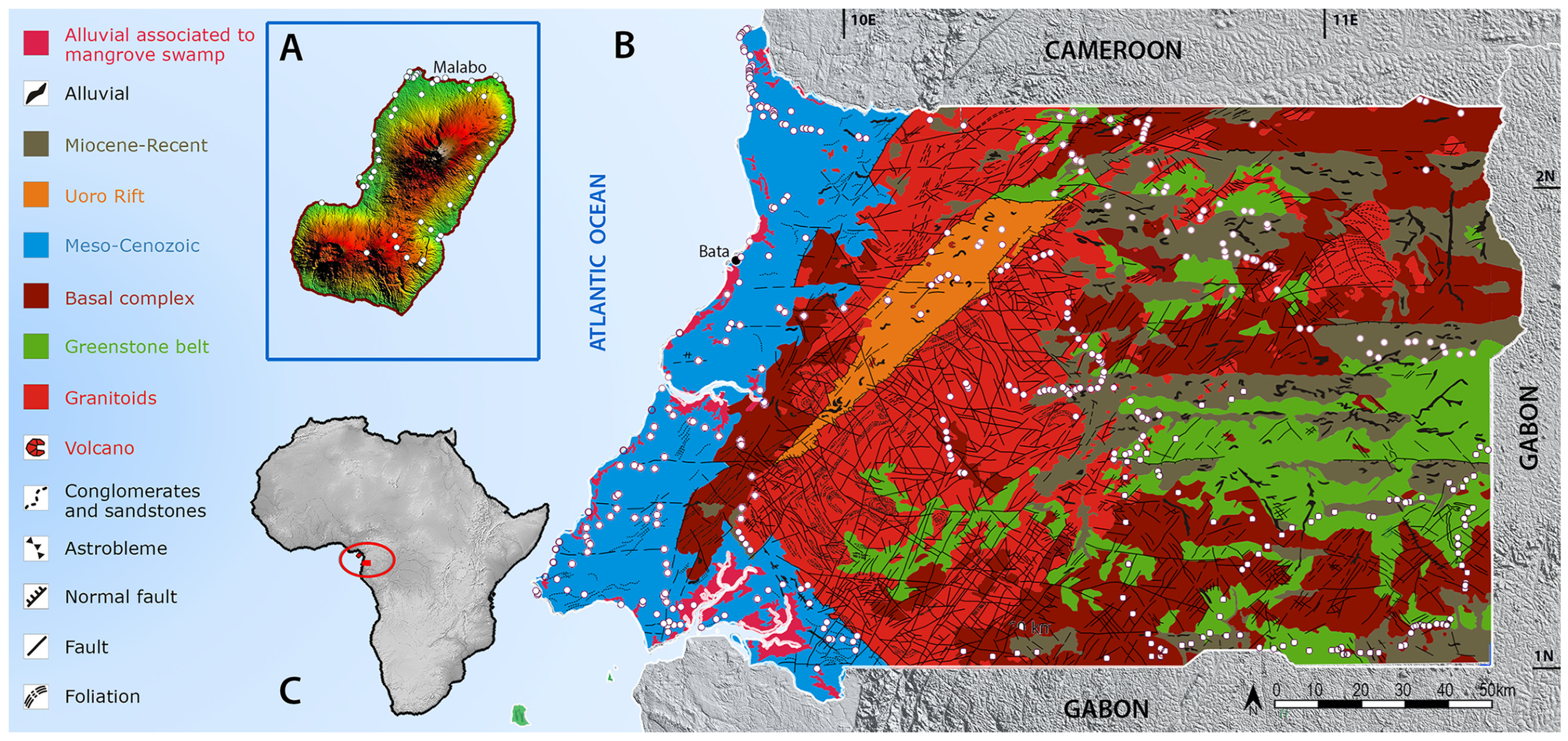
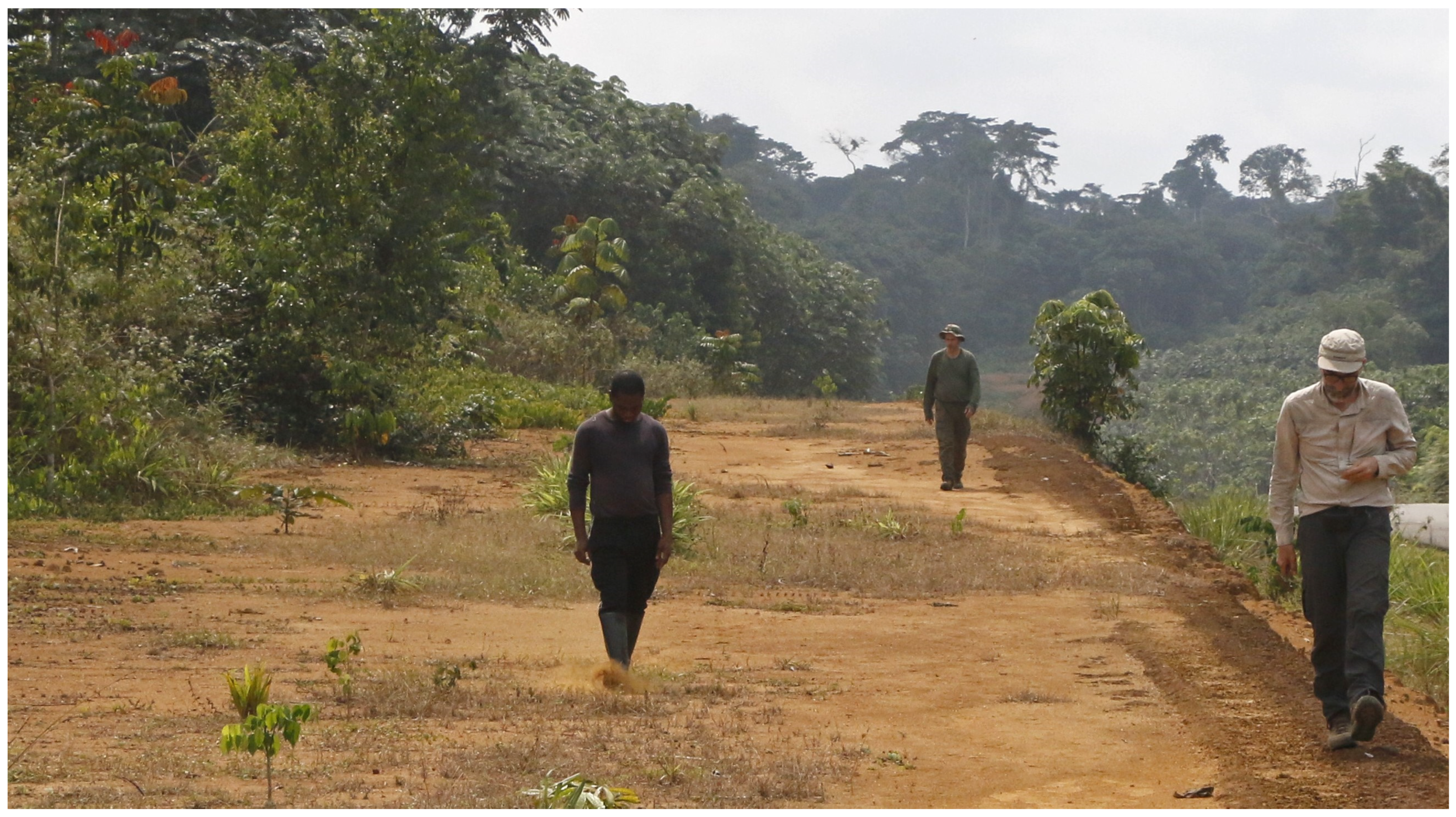
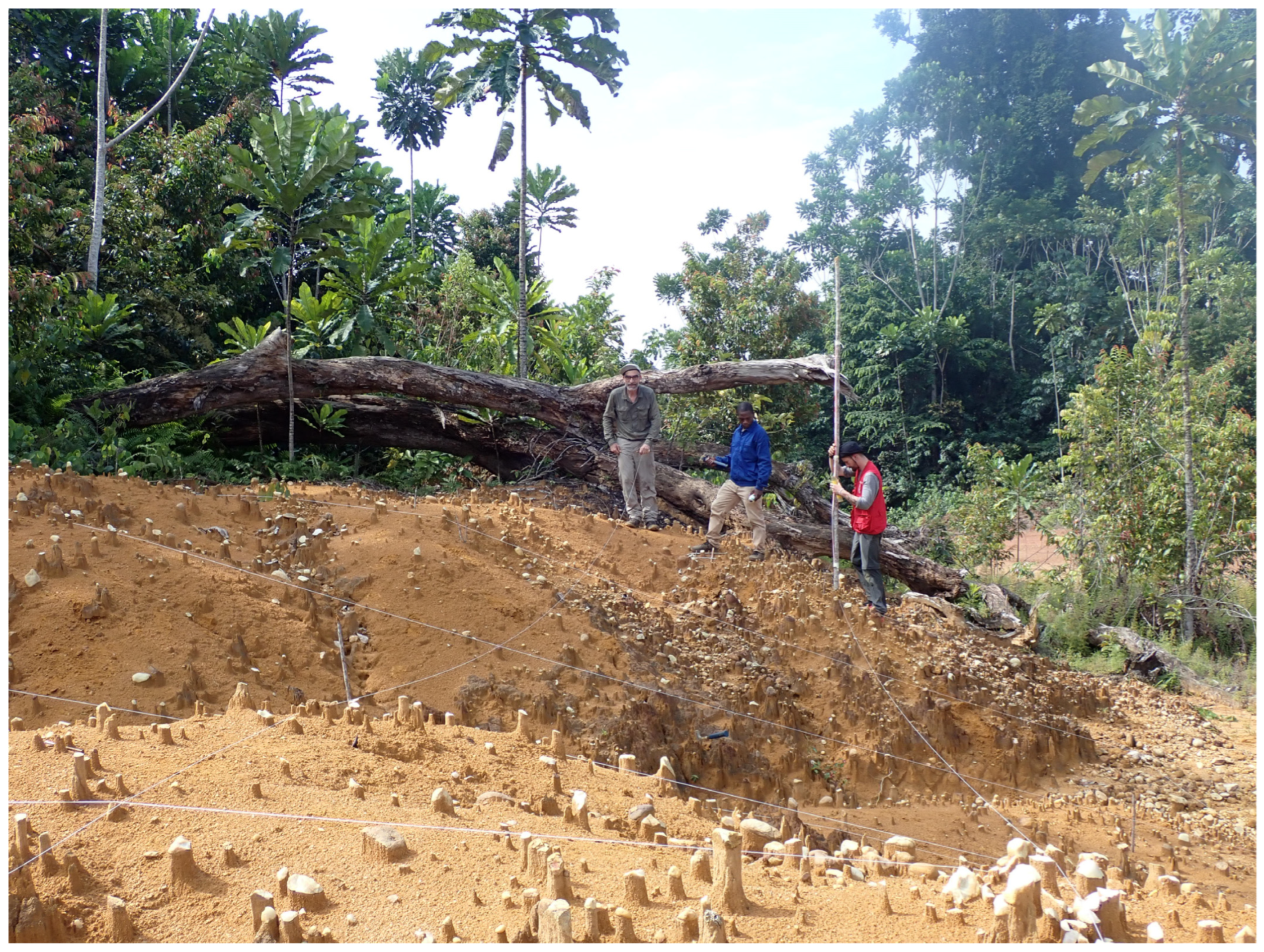
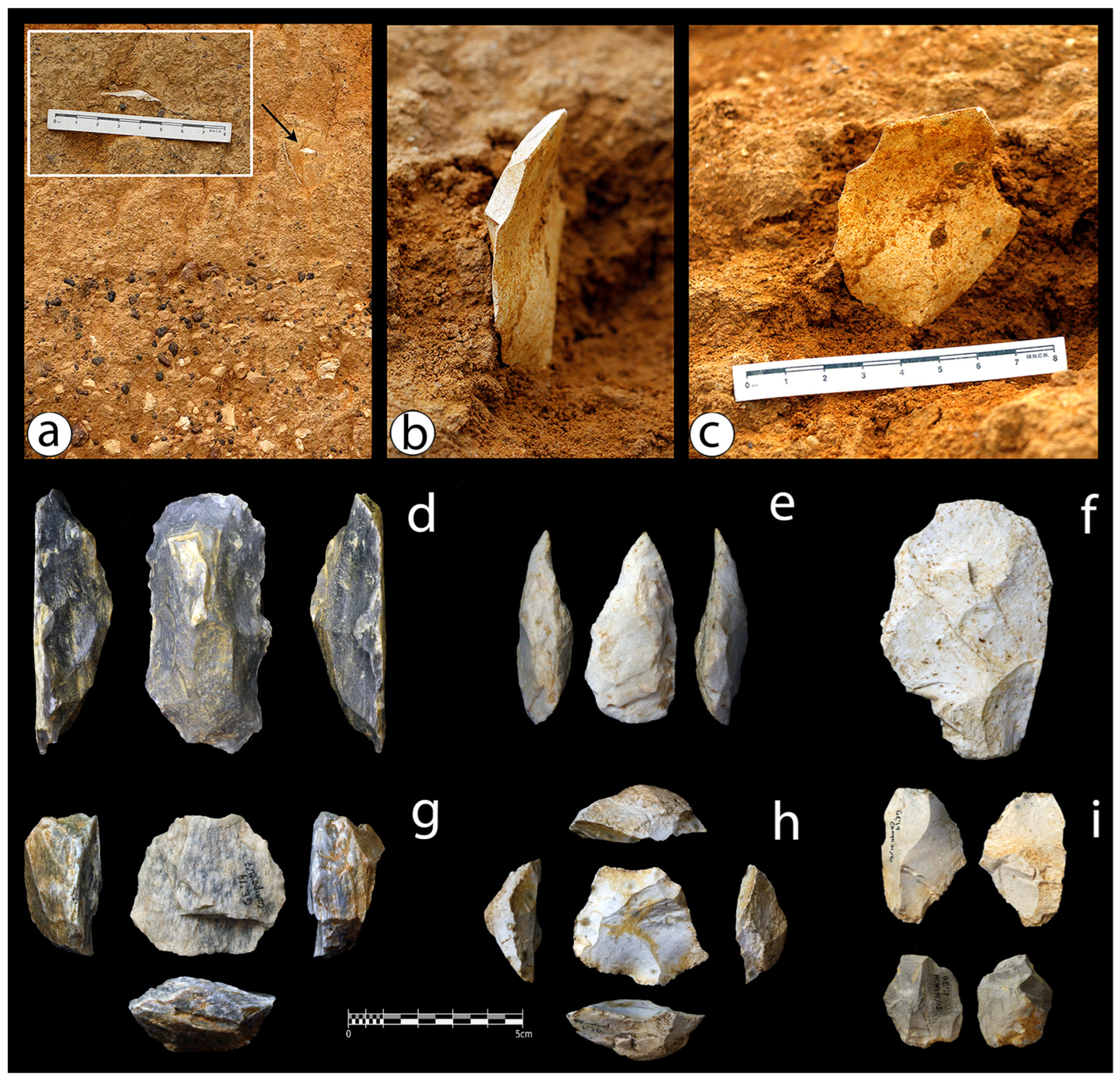

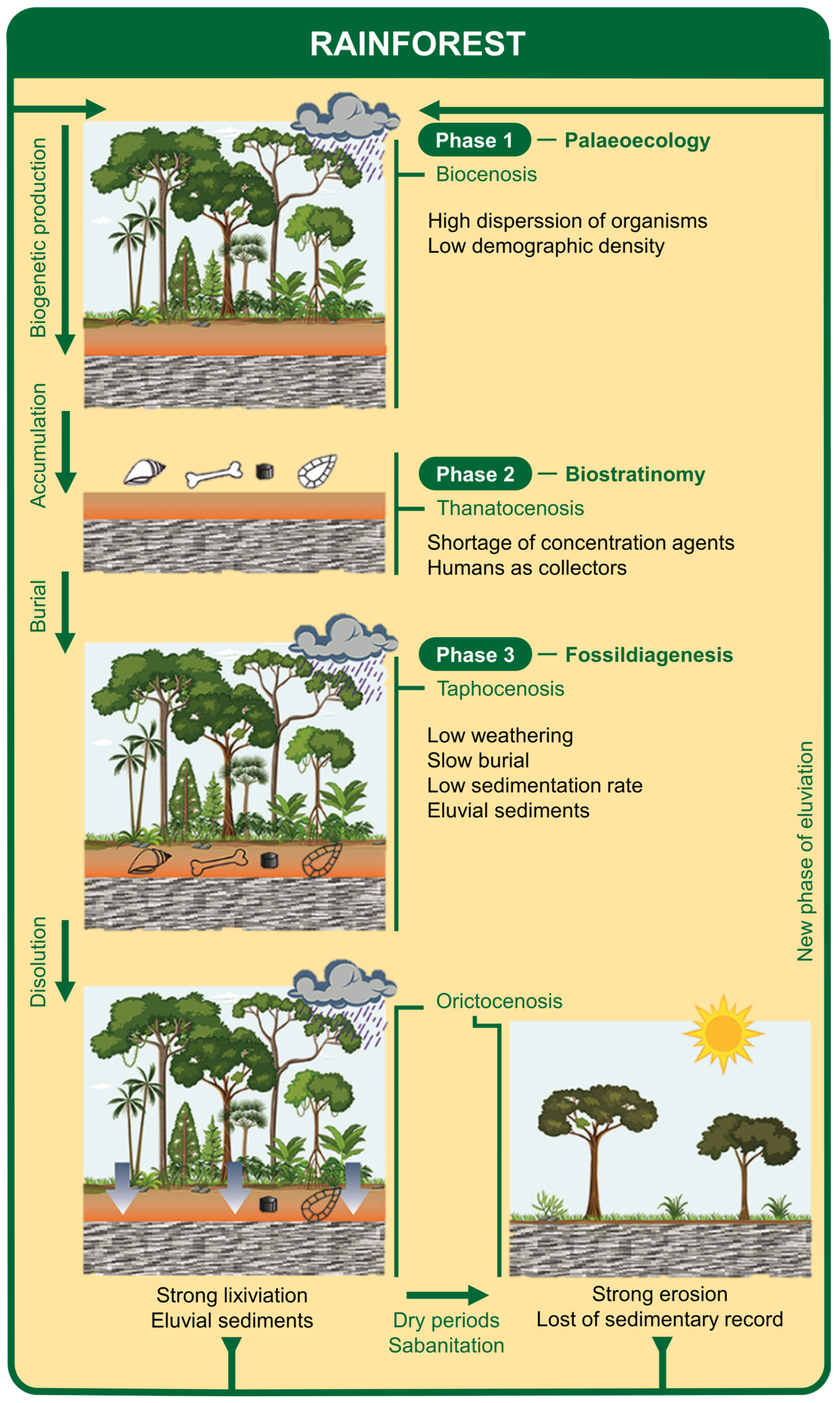
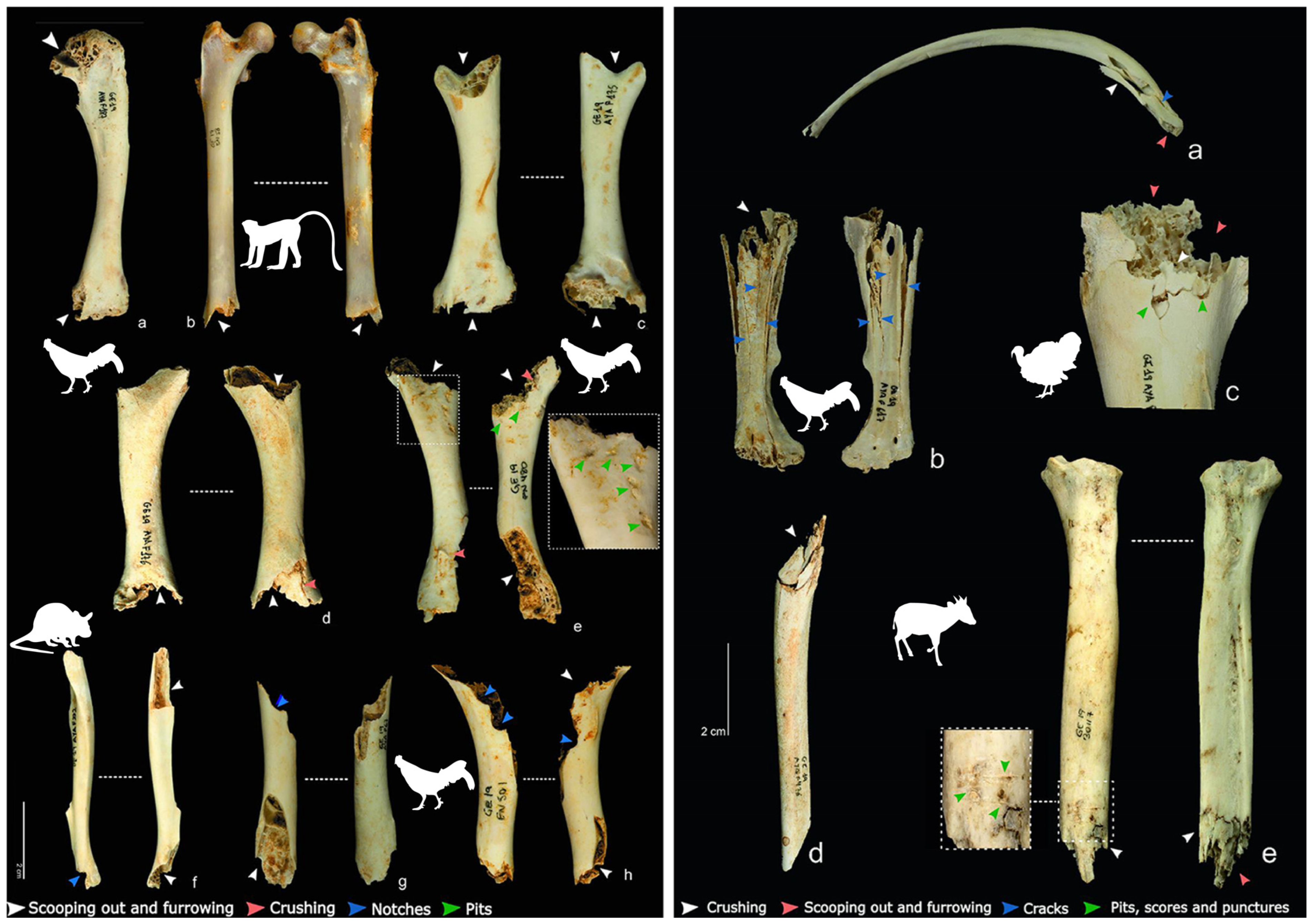
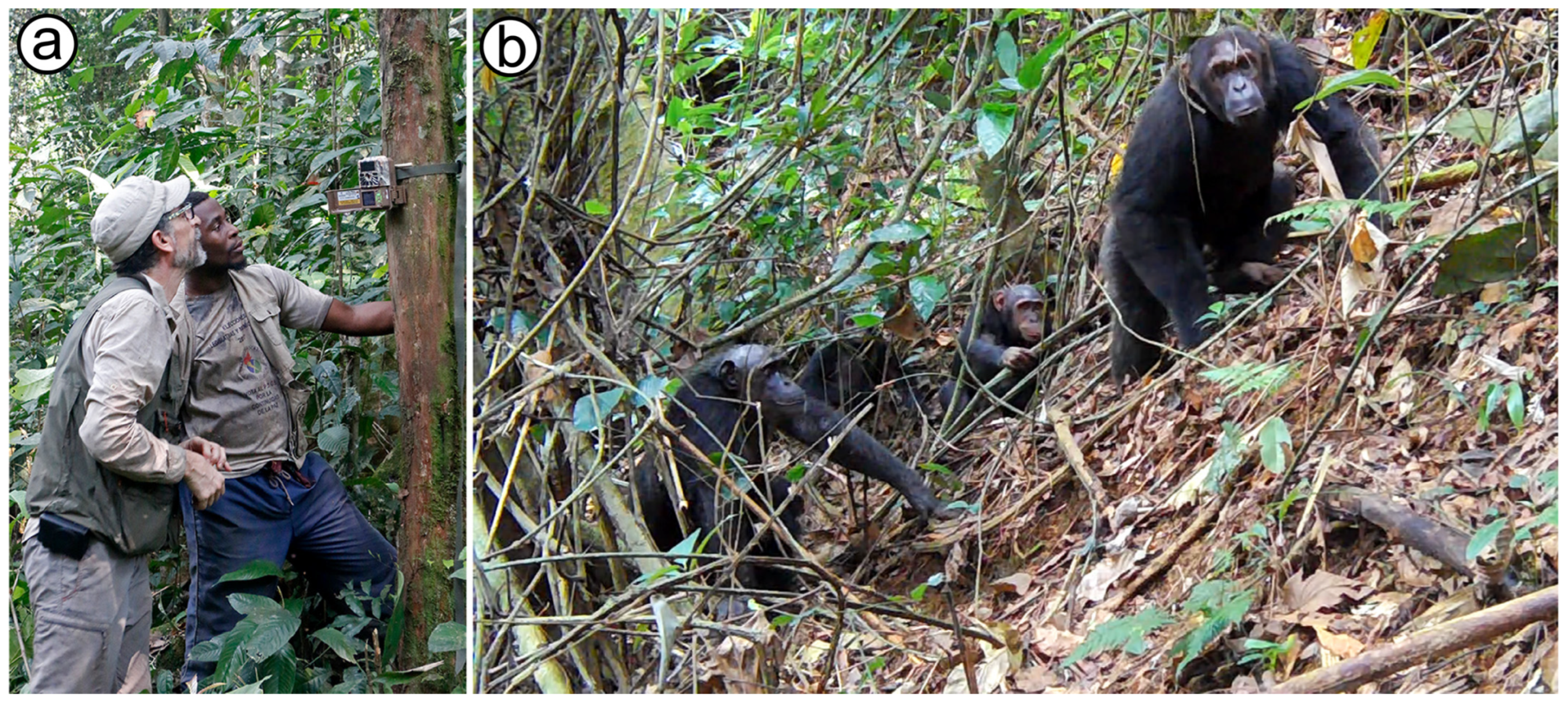
Disclaimer/Publisher’s Note: The statements, opinions and data contained in all publications are solely those of the individual author(s) and contributor(s) and not of MDPI and/or the editor(s). MDPI and/or the editor(s) disclaim responsibility for any injury to people or property resulting from any ideas, methods, instructions or products referred to in the content. |
© 2025 by the authors. Licensee MDPI, Basel, Switzerland. This article is an open access article distributed under the terms and conditions of the Creative Commons Attribution (CC BY) license (https://creativecommons.org/licenses/by/4.0/).
Share and Cite
Rosas, A.; Garcia-Tabernero, A.; Fidalgo, D.; Morales, J.I.; Saladié, P.; Fero Meñe, M.; Ebana Ebana, C. Exploring Early Human Presence in West Central Africa’s Rainforests: Archeo-Paleontological Surveys, Taphonomy, and Insights from Living Primates in Equatorial Guinea. Quaternary 2025, 8, 45. https://doi.org/10.3390/quat8030045
Rosas A, Garcia-Tabernero A, Fidalgo D, Morales JI, Saladié P, Fero Meñe M, Ebana Ebana C. Exploring Early Human Presence in West Central Africa’s Rainforests: Archeo-Paleontological Surveys, Taphonomy, and Insights from Living Primates in Equatorial Guinea. Quaternary. 2025; 8(3):45. https://doi.org/10.3390/quat8030045
Chicago/Turabian StyleRosas, Antonio, Antonio Garcia-Tabernero, Darío Fidalgo, Juan Ignacio Morales, Palmira Saladié, Maximiliano Fero Meñe, and Cayetano Ebana Ebana. 2025. "Exploring Early Human Presence in West Central Africa’s Rainforests: Archeo-Paleontological Surveys, Taphonomy, and Insights from Living Primates in Equatorial Guinea" Quaternary 8, no. 3: 45. https://doi.org/10.3390/quat8030045
APA StyleRosas, A., Garcia-Tabernero, A., Fidalgo, D., Morales, J. I., Saladié, P., Fero Meñe, M., & Ebana Ebana, C. (2025). Exploring Early Human Presence in West Central Africa’s Rainforests: Archeo-Paleontological Surveys, Taphonomy, and Insights from Living Primates in Equatorial Guinea. Quaternary, 8(3), 45. https://doi.org/10.3390/quat8030045





